Princess Kate Middleton William Royal Wedding Gold Solid Silver Coin Proof Stamp
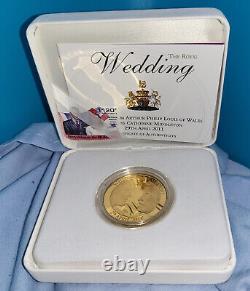
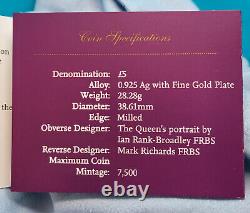
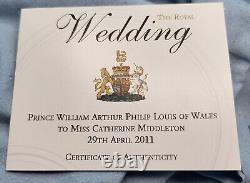

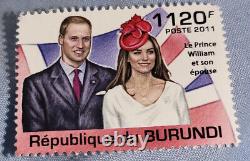
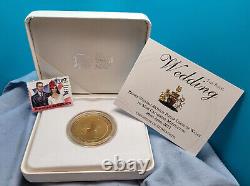
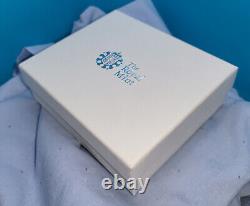


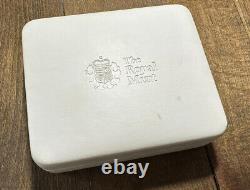

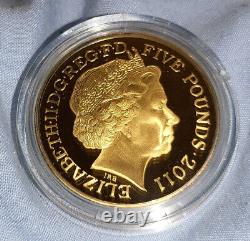
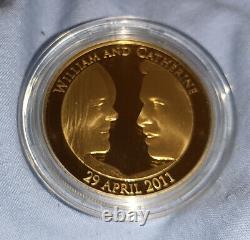
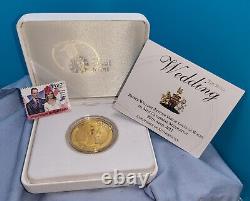
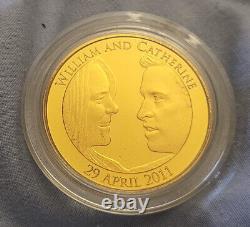
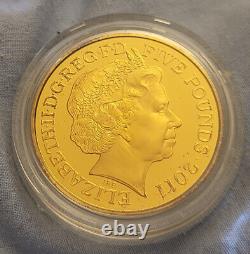
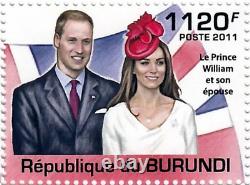
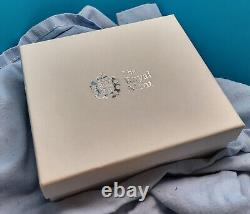

Prince William & Kate Coin, Case, COA + Box plus Stamp. There were only 7,500 Minted.
Also included is a 2011 Royal W. It also has its original Certificate of Authenticity. It has never been removed from its original air tight case. 925 sterling silver coin commemorates the wedding of second-in-line to the throne, Prince William, and Catherine Middleton.
Held at Westminster Abbey on 29 April 2011, the much anticipated marriage was watched by TV viewers around the world and celebrated by The Royal Mint with a series of Five Pound coins, including this 28.28 gram piece. To the obverse this coin shows Ian Rank-Broadley's portrait of William's grandmother, Queen Elizabeth II, the fourth such official effigy to appear on her coinage. The reverse shows a special double portrait of the royal couple, facing each other. This was designed by sculptor Mark Richards and is surrounded by the inscription'WILLIAM AND CATHERINE' above with the ceremony date below ('29 APRIL 2011').Struck to impeccable proof standard, this plated edition (the first of its kind) is one of a limited edition of just 7,500. Offered in its original bridal white box from The Royal Mint with a numbered certificate of authenticity. Obverse Fourth definitive coinage portrait of Elizabeth II by Ian Rank-Broadley. Legend:'ELIZABETH · II · D · G · REG ·F · D FIVE POUNDS · 2011'.
Reverse Twin portrait of Kate Middleton and Prince William, close-up, facing each other. Above:'WILLIAM AND CATHERINE,' below:'29 APRIL 2011'. Specification 28.28 grams of. 925 sterling silver, plated with fine gold. Presentation From a limited issue of just 7,451 pieces which has proved very popular.
Offered in its original white box from The Royal Mint with a numbered certificate of authenticity. Condition The images provided of this product are stock photos. The coin you receive will be from the same issue and will have the same specifications. Some modern UK coins naturally develop toning or milk spots over time and these features may be present on the coin you receive. 925 sterling silver with fine gold plating Diameter: 38.61 millimetres Finished to proof standard Face value: Five Pounds Obverse shows fourth portrait of Elizabeth II Reverse features double portrait by Mark Richards Offered in original box with numbered certificate of authenticity Steeped in more than 1,100 years of history, The Royal Mint supplies all of the United Kingdom's coinage as well as currency for nations around the world.Renown for craftsmanship and thoughtful design, The Royal Mint also produces commemorative coins, favoured by investors and collectors. A Millennia of Minting Founded in the reign of Alfred the Great, around the year 886, The Royal Mint was originally one of several mints which were centralised to London in 1279.
For more than 800 years the Mint was based at the Tower of London before moving to Royal Mint Court where it remained until the 1960s. The Royal Mint has always been on the forefront of economic, technical and artistic innovation. Its skilled craftsmen minted coins that would reach the far corners of the British Empire, establishing the image and reputation of Britain for all whose pockets they ended up in. In 2010 The Royal Mint became a limited company owned by Her Majesty's Treasury.
In recent years the Mint has struck medals for the 2012 London Olympic Games and opened a visitor centre, The Royal Mint Experience, in Llantrisant, Wales: the current home of The Royal Mint. Collecting and Investing The Royal Mint's commemorative and bullion coins - often minted to mark important national events and anniversaries - are not intended for circulation. They might look like ordinary coins but they are generally worth much more, thanks to their scarcity, finish and composition. Most commemorative coins produced by The Royal Mint are available in a range of striking standards including Gold Proof, Silver Proof, Brilliant Uncirculated and Bullion. Some are also available in collectors sets.
Gold and Silver Proof coins are minted in small numbers, making them rare and desirable. The Royal Mint at The Britannia Coin Company The Britannia Coin Company is proud to stock official commemorative coins from The Royal Mint as well as a wide range of historic Royal Mint coinage. We offer unbeatable value on The Royal Mint coins, backed by our reputation for honesty and integrity, built over more than a decade of trading. Would make an Magnificent Gift for any who likes the Royal Family or a Keepsake to remember a great day. In Good Condiiton for its age 13 years old. Please Check out my other Royal Family Coins > Check out my other items. I have got married recently and need to raise funds to meet the costs also we are planning to move into a house together. Check out my other items. Western Europe takes up to 2 weeks. Eastern Europe up to 5 weeks. North America up to 6 weeks.South America, Africa and Asia up to 8 weeks and. Australasia up to 12 weeks. For that Interesting Conversational Piece, A Birthday Present, Christmas Gift, A Comical Item to Cheer Someone Up or That Unique Perfect Gift for the Person Who has Everything....
You Know Where to Look for a Bargain! Minor Pacific Islands (US) U.
Virgin Islands (US) Uganda Ukraine United Arab Emirates United Kingdom United States Uruguay Uzbekistan Vanuatu Vatican City Venezuela Vietnam Wallis and Futuna (FR) Yemen Zambia Zimbabwe and major cities such as Tokyo, Yokohama, New York City, Sao Paulo, Seoul, Mexico City, Osaka, Kobe, Kyoto, Manila, Mumbai, Delhi, Jakarta, Lagos, Kolkata, Cairo, Los Angeles, Buenos Aires, Rio de Janeiro, Moscow, Shanghai, Karachi, Paris, Istanbul, Nagoya, Beijing, Chicago, London, Shenzhen, Essen, Düsseldorf, Tehran, Bogota, Lima, Bangkok, Johannesburg, East Rand, Chennai, Taipei, Baghdad, Santiago, Bangalore, Hyderabad, St Petersburg, Philadelphia, Lahore, Kinshasa, Miami, Ho Chi Minh City, Madrid, Tianjin, Kuala Lumpur, Toronto, Milan, Shenyang, Dallas, Fort Worth, Boston, Belo Horizonte, Khartoum, Riyadh, Singapore, Washington, Detroit, Barcelona,, Houston, Athens, Berlin, Sydney, Atlanta, Guadalajara, San Francisco, Oakland, Montreal, Monterey, Melbourne, Ankara, Recife, Phoenix/Mesa, Durban, Porto Alegre, Dalian, Jeddah, Seattle, Cape Town, San Diego, Fortaleza, Curitiba, Rome, Naples, Minneapolis, St. Paul, Tel Aviv, Birmingham, Frankfurt, Lisbon, Manchester, San Juan, Katowice, Tashkent, Fukuoka, Baku, Sumqayit, St. Louis, Baltimore, Sapporo, Tampa, St. Petersburg, Taichung, Warsaw, Denver, Cologne, Bonn, Hamburg, Dubai, Pretoria, Vancouver, Beirut, Budapest, Cleveland, Pittsburgh, Campinas, Harare, Brasilia, Kuwait, Munich, Portland, Brussels, Vienna, San Jose, Damman, Copenhagen, Brisbane, Riverside, San Bernardino, Cincinnati and Accra.
Prince William and Catherine Middleton: The Royal Wedding of 2011 United Kingdom Written by Fact-checked by Article History Prince William and Catherine, duke and duchess of Cambridge Prince William and Catherine, duke and duchess of Cambridge See all media Date: April 29, 2011 Location: London United Kingdom England Key People: William, prince of Wales Catherine, princess of Wales The royal wedding procession: Prince William and Catherine Middleton The royal wedding procession: Prince William and Catherine Middleton Map of the procession route for the wedding of Prince William and Catherine Middleton, London, April 29, 2011. The wedding on April 29, 2011, of Prince William of Wales to his longtime girlfriend, Catherine Middleton, prompted lavish preparations in the United Kingdom. Though many of the finer details surrounding the wedding were closely guarded by the British royal family, especially so that the couple could maintain some privacy and preserve a few elements of surprise, public curiosity prompted the royal family, in the weeks leading up to the event, to release a number of facts about the eagerly anticipated nuptials, which the media dubbed the wedding of the century. In this special feature, Britannica profiles the couple and their courtship and provides some key facts of that day, notably the route of the royal procession and the family tree of the house of Windsor, as well as excerpts from Britannica's past coverage of British royal nuptials. The couple Prince William of Wales Prince William of Wales Prince William of Wales Prince William of Wales, 2008.
William Arthur Philip Louis Windsor was born on June 21, 1982, in Paddington, London, the elder son of Charles, prince of Wales, and Diana, princess of Wales, and second in line (after Charles) to the British throne. The following year he spent traveling before enrolling at the University of St. Andrews in Scotland, where he would study art history, social anthropology, and geography. Having been exposed to charitable activities early in his life, he devoted the year to volunteering in Chile, working at a British dairy farm, and visiting Belize and various African countries.
In 2005 William graduated from St. Andrews with a degree in geography, and the following year he entered the Royal Military Academy Sandhurst; he received his commission in the Household Cavalry in 2006. Despite his willingness to join British forces in Iraq, military officials suggested that neither William nor his younger brother, Harry, should serve, because they could become specific targets of attack, thereby putting their fellow soldiers at risk. (Harry briefly served in Afghanistan, however). In 2008 William went on attachment to the Royal Air Force and then to the Royal Navy, so that he could gain experience in all three major branches of the armed services. In 2010 he completed his training as a helicopter pilot in the RAF Search and Rescue Force and began a tour of duty in Wales. William ranks among the most popular figures of the royal family. Much like his father, William is an avid sportsman.He was admired for his public poise and grace following his mother's death in a car crash in Paris in 1997, and 10 years later William and Harry organized a London memorial service to mark the anniversary of her death. Catherine Elizabeth Middleton Catherine Middleton Catherine Middleton Catherine Middleton, 2008. Catherine Elizabeth Middleton was born on January 9, 1982, in Reading, Berkshire, England, the eldest of three children of Michael and Carole Middleton. Her siblings include a sister, Philippa (Pippa), and a brother, James. The success of that venture, along with a family inheritance, allowed them to send Catherine to a prep school and then to the prestigious Marlborough College in Wiltshire, England.
At Marlborough, Catherine (by then called Kate) was known as a serious, levelheaded student, excelling in both athletics-she captained the school's field hockey team-and academics. In 2001 Kate went on to the University of St.
Andrews in Scotland, where she studied art history. Check out our special academic rate and excel this spring semester!
The courtship How did Prince William and Kate Middleton meet? How did Prince William and Kate Middleton meet?
Learn about the origin of Prince William and Kate Middleton's love story. See all videos for this article Prince William of Wales and Catherine Middleton met in 2001 while art history students at the University of St. At the beginning of their sophomore year at university, they shared a four-bedroom Edwardian townhouse in Fife with two other students, though Middleton was then dating another student. William and Kate were often seen in the company of friends socializing and drinking at their favourite pubs.In 2003 the four friends rented a cottage outside town, and by Christmas of that year the couple was romantically linked. In March 2004 they were photographed together waiting in line for a ski lift at a Swiss resort, thus appearing to confirm their relationship. The following year they enjoyed holidays together abroad and also spent time alone on weekends at a cottage on Queen Elizabeth's Balmoral estate. The couple remained cautious around the paparazzi, though they were reportedly hounded, and they were photographed kissing in January 2006.
In 2007 the couple's relationship took a brief (April-June) hiatus. In April 2008 Kate attended the ceremony at which William received his wings as a qualified RAF pilot. In March 2010 Prince William moved into a cottage in northern Wales, which was near his RAF Valley post on Anglesey; Kate moved into the cottage that June. The engagement Prince William of Wales and Catherine Middleton Prince William of Wales and Catherine Middleton Prince William of Wales and Catherine Middleton, St. James's Palace, London, 2010. Following several years of intense speculation from the British media about the couple's marriage plans-during which time Kate was dubbed "Waity Katie"-it was announced in November 2010 that the two were engaged. In October 2010 William proposed to Kate while on holiday in Kenya. Following her engagement, she reverted to the more formal Catherine.On November 16, 2010, Clarence House (the official residence of the Prince of Wales and his wife Camilla, duchess of Cornwall [formerly Camilla Parker Bowles]) confirmed the engagement. The ring bestowed to Catherine was the 18-carat white gold engagement ring that includes a large oval sapphire surrounded by 14 round diamonds that was first worn by William's mother, Princess Diana. It had been created by then royal jeweler Garrard.
Prince William and Catherine, duke and duchess of Cambridge Prince William and Catherine, duke and duchess of Cambridge Prince William and his bride, Catherine, leaving Westminster Abbey after their wedding, April 29, 2011. Prime Minister David Cameron proclaimed the day to be a national holiday.
The venue was Westminster Abbey, where William's grandparents Queen Elizabeth II and Prince Philip were married (November 20, 1947) and where his mother's funeral service was held (1997). The officiants of the ceremony included the dean of Westminster, the Very Reverend John Hall, who conducted the wedding service; the archbishop of Canterbury, the Most Reverend and Right Honourable Dr. Rowan Williams, who married the couple; and the bishop of London, the Right Reverend and Right Honourable Dr. Richard Chartres, who gave the address. The occasion was dubbed a "semi-state wedding" rather than a formal state occasion because William was neither the sovereign nor the direct heir to the throne.
Nearly 1,900 guests attended the ceremony, including heads of state of the Commonwealth, crown royals from around the world, and friends and family of the bride and groom. On the eve of the wedding, Catherine and her immediate family stayed overnight at the Goring Hotel near Buckingham Palace. The couple rode in the royal carriage used by William's parents at their 1981 nuptials. Sarah Burton, who took over as creative director of Alexander McQueen (a part of PPR) after the designer's suicide in 2010, designed a floor-length ivory dress for the bride that combined tradition with modernity. The long-sleeved dress, which narrowed at the waist and was padded at the hip (a signature of McQueen's design), was made of white satin gazar and featured a lace-applique bodice that was handmade, along with the skirt, by the Royal School of Needlework.
The skirt of ivory silk tulle incorporated the symbolic rose of England, thistle of Scotland, daffodil of Wales, and shamrock of Ireland. The bride wore a Cartier halo diamond tiara that was made in 1936 and given to Queen Elizabeth by her mother and a full veil made of Chantilly lace.
Her train measured 9 feet (2.7 metres). The wedding dress and the name of its designer had remained shrouded in secrecy until the day of the wedding.
In accordance with tradition, the bride's bouquet contained a sprig of myrtle from the bush grown from the myrtle included in the bouquet carried by Queen Victoria during her 1840 nuptials. The bouquet also featured fragrant white hyacinth, lily of the valley, ivy, and sweet William. Per custom, the bouquet was later placed on the grave of the Unknown Warrior at Westminster Abbey.Prince William broke with protocol and asked his brother, Harry, to serve as his best man. When the groom is of royal birth, he usually has a "supporter" rather than a best man. Two pages (honorary attendants) were also selected: (1) William (Billy) Lowther-Pinkerton, who was the 10-year-old son of James (Jamie) Lowther-Pinkerton (Jamie served as William and Harry's part-time private secretary) and Susannah Lowther-Pinkerton (née Richards), and (2) Tom Pettifer, who was the eight-year-old son of Charles Pettifer and Alexandra ("Tiggy") Pettifer (née Legge-Bourke) and was William's godson. Catherine's maid of honour was her sister, Pippa. Catherine selected four additional bridesmaids: (1) Lady Louise Windsor, who was the seven-year-old daughter of the earl and countess of Wessex, Prince Edward and Sophie, (2) the Honourable Margarita Armstrong-Jones, the eight-year-old daughter of Viscount and Viscountess Linley, (3) Grace van Cutsem, who was the three-year-old daughter of Hugh and Emilie van Cutsem and was William's goddaughter, and (4) Eliza Lopes, who was the three-year-old daughter of Harry Lopes and Laura Lopes (née Parker Bowles) and granddaughter of the duchess of Cornwall.
Catherine Middleton: wedding Catherine Middleton: wedding Catherine Middleton (left) sharing a smile with her sister, maid of honour Pippa Middleton, as she prepares to enter Westminster Abbey, London, for her wedding to Prince William, April 29, 2011; both dresses were designed by Sarah Burton. A reception for about 600 guests-who enjoyed wine, champagne, and canapés-was hosted by the queen at Buckingham Palace and was followed a few hours later by a dinner dance hosted by Prince Charles for 300 guests. For the reception, Catherine wore a dress that, like her wedding dress, was designed by Sarah Burton. The all-white strapless satin gown featured a sweetheart neckline, a circle skirt, and a diamanté-embroidered detail around the waist. It was paired with a white angora bolero cardigan.
The wedding cake was a multitiered fruitcake created by English pastry chef and entrepreneur Fiona Cairns. A chocolate biscuit (cookie) cake made by McVitie's Cake Company was also served. The couple asked that all gifts be sent in the form of donations to the Royal Wedding Charity Fund, a subset of the Foundation of Prince William and Prince Harry, which was established in September 2009. On the day of the wedding, Queen Elizabeth gave William the title duke of Cambridge (in keeping with his status as second in line to the throne). In addition, he was named earl of Strathearn (a Scottish title) and Baron Carrickfergus.Catherine was given the title duchess of Cambridge. If the queen had not conferred a new title, Catherine would have been known as Princess William. Catherine wore a wedding band made of traditional Welsh gold that is owned by the royal family. William, however, broke with tradition and decided to forego wearing a wedding band entirely, because of his personal distaste for jewelry.
The day prior to the wedding, it was reported that Prince William and Catherine had invited British singer Ellie Goulding to perform at their wedding reception. Karen Sparks Britannica's coverage of past British royal weddings Since Victoria's wedding to Albert in February 1840, their descendants-the members of the house of Windsor-have been parties to more than two dozen weddings. Some of those marriages were brief, others long; death parted some of the couples, while others divorced. The following excerpts from past editions of the Britannica Book of the Year, which began publication in 1938, capture a vivid history of British royal weddings during the 20th century.
Prince Edward, duke of Windsor, and Wallis Warfield duke and duchess of Windsor duke and duchess of Windsor The duke and duchess of Windsor. In 1938 the Britannica Book of the Year published a biography of the man who, until December 1936, was known as Edward VIII. That woman was the American socialite Wallis Warfield, known as Wallis Warfield Simpson when she began a friendship with Edward in 1930; she had been once divorced then, and in 1936 she would begin pursuing divorce from her second husband. Her history, however, rendered her a politically unpalatable wife for Edward. They married in 1937 and spent much of the following decades in continental Europe. Not until 1967 were they invited to participate in an official public ceremony with other members of the royal family. The Duke of (1894-), formerly H.King Edward VIII of Great Britain and Ireland; the eldest son of King George V, he succeeded to the throne on Jan. 20, 1936, but in view of the advice of his ministers that his projected marriage with Mrs. Simpson, an American citizen whose second divorce was then pending, was incompatible with his retention of the throne, he abdicated on Dec.
11 of the same year, leaving England for Austria, where he took up residence at Schloss Enzesfeld, the home of the Baron Eugene de Rothschild. 1937, the duke was visited by his sister, the princess royal, and her husband the earl of Harewood; and on March 29 he removed from Enzesfeld to St. On May 4 he joined at the Chateau de Candé, near Tours, Mrs.
Simpson (who had meanwhile resumed her maiden name of Warfield), the formalities of whose divorce from her husband Mr. Ernest Simpson, had been completed on the previous day, and on June 3 his marriage with Mrs. Wallis Warfield took place at the chateau, an Anglican clergyman performing the religious ceremony. It had been officially announced a few days previously that the style of "Royal Highness, " enjoyed by the duke, would not be shared by his wife or descendants, if any. After the marriage the duke and duchess travelled to the Castle of Wasserleonburg, in Carinthia, for their honeymoon, remaining there until September, when they removed to Borsodivanka in Hungary, the home of Mr.
Charles Bedaux, an industrial psychologist unpopular in American labour circles. Princess Elizabeth and Philip Mountbatten, duke of Edinburgh wedding of Princess Elizabeth and Philip, duke of Edinburgh wedding of Princess Elizabeth and Philip, duke of Edinburgh Princess Elizabeth (later Elizabeth II) and Philip Mountbatten, duke of Edinburgh, following their wedding, November 20, 1947.In 1948, in its entry for Great Britain, the Britannica Book of the Year called 1947 a year "of repeated disappointments and steady perseverance" that ended on a note of almost unrelieved austerity. " The wedding of Princess Elizabeth to Philip Mountbatten was, however, a sliver of brightness: "though celebrated with restrained festivity, [it] came as a welcome tonic to the public spirits and was an occasion of joy throughout Britain. Elizabeth became Queen Elizabeth II in 1952, and in 2007 she observed her 60th wedding anniversary, the first ever celebrated by a British monarch. The following biography of Elizabeth appeared in 1948 in the Britannica Book of the Year.
Elizabeth, Princess, Duchess of Edinburgh (1926-), the heiress-presumptive to the British throne, was born on April 21, at London, and until Nov. 1947, when she married the duke of Edinburgh. , was known as Princess Elizabeth. She was 11 when her father was crowned king. The first occasion when she was appointed a counsellor of state was in July 1944, when the king visited the forces in Italy.
She enrolled in the auxiliary territorial service in 1944, and was commissioned with the rank of junior commander. In the early months of 1947 she accompanied the king, queen and Princess Margaret on a state visit to the Union of South Africa. She celebrated her 21st birthday in Capetown, and in a broadcast to the empire she declared, My whole life shall be devoted to your service.
A court circular from Buckingham palace on July 9 announced her betrothal to Lt. And the marriage was solemnized in Westminster abbey on Nov. Philip Mountbatten was created duke of Edinburgh, and after the wedding she was known officially as H. Princess Elizabeth, the Duchess of Edinburgh.
The wedding service was conducted by the archbishop of Canterbury, assisted by the archbishop of York and the dean of Westminster. During the summer Princess Elizabeth opened the royal Welsh agricultural show at Carmarthen, addressed the Church of England Youth council at Canterbury, launched the liner "Caronia" on Clydebank, was elected president of the Royal Society of Arts, and on July 16 created a burgess of Edinburgh. On the occasion of the king's birthday honours she was awarded the Imperial Order of the Crown of India and on the eve of her wedding appointed a lady of the Order of the Garter.
Princess Margaret and Antony Armstrong-Jones Princess Margaret Princess Margaret Princess Margaret, photograph by Cecil Beaton, 1951. In 1961 the Britannica Book of the Year published a biography of Princess Margaret Rose, sister of Queen Elizabeth II. Her engagement to the photographer Antony Armstrong-Jones (who would become the earl of Snowdon) came as a thunderclap when it was announced in February 1960; their wedding followed in May. But she had already been much in the spotlight in the 1950s, particularly after she renounced suitor Capt. Peter Townsend as a prospective husband; she could not marry him because of his previous divorce.An obituary of Margaret published in the Britannica Book of the Year in 2003 concisely summarized the unraveling of her marriage to Armstrong-Jones: By the 1970s, however, times had changed; both of the Snowdons engaged in public love affairs, and the volatile marriage finally ended in divorce (1978), the first in the British royal family in 400 years. Margaret Rose, second daughter of King George VI and Queen Elizabeth, was born at Glamis castle, Angus, Scot. She had a quiet childhood, mostly spent at the royal lodge, Windsor, and was taught mainly by a governess until Feb. 1947, when she went with her parents and sister to South Africa.
Her first important engagement alone was in Sept. 1948, when she represented her father at the investiture of Queen Juliana of the Netherlands.After the death of her father in 1952 she was much drawn to persons associated with him, among them Group Captain Peter Townsend, a member of King George's staff, who had divorced his wife. Newspaper comment on the princess's attachment made it necessary for Townsend to leave the royal service.
Early in 1955 Princess Margaret carried out her first Commonwealth tour alone, to the British Caribbean islands. 31, 1955, after much speculation concerning the princess and Townsend she issued a statement that she had decided not to marry him.She made a tour of east Africa and Mauritius in 1956 and attended the inauguration of the first parliament of The West Indies in 1958. Names of people whom she might marry were frequently mentioned, but astonishment was great when, on Feb. 26, 1960, her engagement to Antony Armstrong-Jones, a photographer, was announced.
The wedding took place in Westminster abbey on May 6. After a honeymoon voyage to the West Indies aboard the royal yacht, the couple took up residence at Kensington palace. Princess Anne and Mark Phillips The marriage of Princess Anne and Capt. Mark Phillips could trace its roots, as a dual biography published in the Britannica Book of the Year in 1974 put it, to their joint interest and prowess in competitive horsemanship.
It was a sport in which, by the early 1970s, both had won team or individual championships. Their wedding in 1973 drew a massive television audience-more than 500 million viewers worldwide, by some estimates. In 1992, however, the marriage ended in divorce; that same year, Anne married Timothy Laurence, a former aide to Queen Elizabeth. The marriage between Princess Anne and Capt. Mark Phillips, celebrated in Westminster Abbey on Nov.
14, 1973, with brilliant ceremony and televised around the world, was undoubtedly the most notable royal event of the year. Not even Prime Minister Edward Heath's declaration of a national state of emergency on the eve of the wedding, in view of a rapidly worsening economic situation, could dim the colourful pomp and circumstance of the occasion. The engagement had been widely expected and was formally announced on May 29. To devoted royalty watchers, the fact that Princess Anne had fallen in love with a commoner probably seemed especially romantic; to others this circumstance appeared an appropriate symbol of the less formal style increasingly adopted by the royal family. The couple had been brought together through their joint interest and prowess in competitive horsemanship, a sport in which both had achieved international status. They first met at a social gathering after the 1968 Mexico Olympic Games, at which Captain (then Lieutenant) Phillips was a reserve rider. Both were members of the British team that won the three-day event at the 1971 European championships at Burghley, Eng.Princess Anne becoming individual European champion. Afterward Captain Phillips went on to become a member of the winning British team at the 1972 Munich W.
Princess Anne, largely because of the indisposition of her most experienced horse, Doublet, was not included in that team or the one sent to Kiev in the U. For the European championships in September 1973. Defending her title there as an individual rider, she withdrew because of a strained shoulder suffered in a fall. Princess Anne, the only daughter of Queen Elizabeth II and Prince Philip, was born on Aug. 15, 1950, at Clarence House, London, and educated at Benenden School, near Grassbrook in Kent. She began to carry out public engagements early in 1969, made various state visits abroad with her parents and her brother Prince Charles, and went alone to Hong Kong (1971) and Ethiopia (February 1973).Captain Phillips was born at Tewkesbury in Gloustershire on Sept. Educated at Marlborough College and the Royal Military Academy, Sandhurst, he followed his father into the Queen's Dragoon Guards. On his mother's side he was descended from a Lutheran German family, a branch of which moved to England early in the 19th century.
Charles, prince of Wales, and Lady Diana Spencer Prince Charles and Princess Diana Prince Charles and Princess Diana Charles, prince of Wales, and Diana, princess of Wales, returning to Buckingham Palace after their wedding, July 29, 1981. In 1982 the Britannica Book of the Year published a dual biography of Prince Charles and Lady Diana Spencer that described their wedding in 1981 as a coming together of "the world's most eligible bachelor" and the girl next door.
The marriage produced two sons, William and Harry, and ended in divorce in 1996. Diana died the following year, and Charles married Camilla Parker Bowles in 2005.
It was to be the year of the fairy tale come true: the announcement was made on Feb. 24, 1981, that the prince of Wales, Prince Charles, heir to the British throne, was to marry a 19-year-old kindergarten teacher, the Lady Diana Spencer. There was, it emerged, one truly fairy-tale aspect to the royal romance.
14, 1948, was to end his media-imposed reign as the world's most eligible bachelor by marrying the girl next door. Prince Charles in recent years had become an increasingly popular member of the royal family.
Well beloved of the press for his mixed fortunes in sporting activities, he also emerged as a serious though unofficial promoter of British business interests abroad. The British public, however, was more concerned to see him take seriously his own statement of some years past that a chap like me might expect to marry at about the age of 30.
Lady Diana, by the time the engagement was announced, had already passed the media test with flying colours. The press photographers had guessed the secret months earlier, and had followed her on her patriotic way to work in her British-Leyland-built Metro and snapped her among her small charges in Pimlico. She was judged to be discreet-no small point in favour of the future wife of the heir to the throne-almost to the point of shyness, a trait that was later belied by her lively sense of humour. Diana was born the Honourable Miss Diana Frances Spencer on July 1, 1961, at Park House, the home that her parents rented on Queen Elizabeth's estate at Sandringham, Norfolk, and where her childhood playmates were the queen's younger sons Prince Andrew and Prince Edward.
The third child and youngest daughter of Edward John, Viscount Althorp, heir to the 7th Earl Spencer, and his first wife, Frances Roche, she became Lady Diana Spencer when her father succeeded to the earldom in 1975. Riddlesworth prep school, Norfolk, and West Heath near Sevenoaks, Kent, provided the young Diana's schooling, during which time she spent summer holidays with her mother in Scotland (her parents divorced when Diana was six). At finishing school in Switzerland she became a competent skier. But little of her previous life could have prepared Lady Diana for her new role as the princess of Wales. The wedding itself, on July 29 in St.
Paul's Cathedral, London, was a spectacular royal occasion and one of national festivity for the British public, shared in by many visitors from abroad and by millions around the world who watched the ceremony on television. More royal news was to follow when, in early November, the couple announced that they were expecting a child in June. Prince Andrew and Sarah Ferguson In 1987 the Britannica Book of the Year published a dual biography of the duke and duchess of York-or, as they were popularly called at the time, Andy and Fergie. The wedding of Prince Andrew, fourth in line to the British throne, to Sarah Ferguson in 1986 produced two daughters, Beatrice and Eugenie, and ended in divorce in 1996. On July 23, 1986, Prince Andrew Albert Christian Edward, second son of Queen Elizabeth II, married Sarah Ferguson, whom he had known since childhood but who had made a late and relatively unobserved appearance as a prospective wife for the man fourth in line to the British throne.
The wedding of "Andy" and "Fergie" was enacted with traditional pomp and circumstance in London's historic Westminster Abbey. Another chapter in the story of royal romances had been concluded. Sarah Margaret Ferguson was born on Oct.
15, 1959, in London and grew up in the village of Sunninghill, near Ascot, Berkshire. Though a commoner, she was very much a member of the British royal social circle.Diana, princess of Wales, a longtime friend, was reported to have encouraged the love match. Ronald Ferguson, was polo manager to Charles, prince of Wales. Her parents were divorced and had both remarried-her mother, Susan, to Argentine polo player Hector Barrantes. An unexceptional upbringing in the country, private school, a job with a London publisher: in these the future duchess of York presented a rather sedate image, compared with some of the girlfriends claimed in the past by Fleet Street newshounds as candidates for Prince Andrew's hand. On being thrust into the public eye, she revealed a bouncy personality and an apparent tolerance of the rigours of public life that made her immediately popular with many British royalty-watchers.
19, 1960, at Buckingham Palace, London, Prince Andrew was educated at Gordonstoun school in Scotland and subsequently attended the Royal Naval College, Dartmouth (Devon). Joining the Royal Navy, he served as a helicopter pilot aboard HMS Invincible during the 1982 Falkland Islands/Islas Malvinas conflict between the U. Immediately after the Falklands campaign, reports that he had gone to relax in the Caribbean with movie actress Koo Stark attracted media interest and (it was suggested) a maternal reprimand. Being fourth in line to the throne meant that Andrew faced less obvious pressures than his elder brother, Charles. However, his commitment to a naval career seemed to have settled the question that historically had perplexed monarchs' younger sons: what to do.Public response to the wedding confirmed the enduring appeal of the monarchy to most Britons. The newlyweds received an additional wedding gift from the queen: the titles of duke and duchess of York. The dukedom of York, traditionally given to the sovereign's second son, was last held by the queen's father, later King George VI. Prince Andrew was the 13th holder of the title. Prince Edward and Sophie Rhys-Jones Prince Edward, earl of Wessex, and Sophie, countess of Wessex Prince Edward, earl of Wessex, and Sophie, countess of Wessex Prince Edward, earl of Wessex, with his wife, Sophie, countess of Wessex, 2015.
"Relatively quiet" were the words used in 2000 by the Britannica Book of the Year to describe the wedding of Prince Edward and Sophie Rhys-Jones, who were also the subject of a dual biography that year. That tone seemed appropriate for a ceremony, held in June 1999 at Windsor Castle, that came only two years after the death of Diana, princess of Wales, in a car crash in Paris.
The marriage produced two children, Louise and James. On June 19, 1999, Prince Edward, the youngest child of the U. S Queen Elizabeth II, married Sophie Rhys-Jones, a public relations consultant. The couple insisted it was an informal, family occasion-and so it was, within the constraints imposed by a wedding attended by Britain's royal family on the grounds of Windsor Castle and watched on television by an estimated 200 million viewers around the world.On the wedding day, the queen bestowed on Edward the title earl of Wessex and Viscount Severn (the senior title represented a geographic reference that could be found only in history books, for Wessex had ceased to be a formal region of England many centuries earlier). The wedding provided a rare moment of joy for the royal family, which had endured much disappointment in preceding years, including the failed first marriages of each of Edward's three older siblings and the death in 1997 of Prince Charles's former wife, Diana, princess of Wales. Edward Anthony Richard Louis, seventh in line to the U. Throne, was born at Buckingham Palace in London, on March 10, 1964. He attended Gordonstoun School, a spartan boarding school in Scotland, and studied history at Jesus College, Cambridge.
After Cambridge, Edward joined the Royal Marines but resigned his commission in 1987 in the middle of commando training. He worked briefly for musical theatre composer Andrew Lloyd Webber before setting up his own theatrical production company. In 1993 he set up Ardent Productions, Ltd.
Which survived, mainly through making programs about the royal family's past history, though seldom making profits. Despite these ups and downs, Edward won respect for his attempts to be the first child of a monarch to seek a career in the private sector. Sophie Helen Rhys-Jones was born in Oxford on Jan. Educated at West Kent College, a private girls' day school, and a local secretarial college, she worked briefly in a bar, followed by spells as a press officer for Capital Radio (a London-based popular music station) and as a holiday representative at a winter sports resort in Switzerland.
There she became romantically involved with an Australian ski instructor and followed him to Australia. In 1996, with business partner Murray Harkin, she set up a public relations company, R-J H. On her engagement to Prince Edward, she made it clear that she intended to continue with her career when she was married. The new countess, who changed her professional name to Sophie Wessex, was considered more down-to-earth and self-confident than Diana had been and more settled and career-minded than Prince Andrew's former wife, Sarah, duchess of York, and was welcomed into the royal family as someone who might stay the course and help it restore its tarnished reputation.The Princess of Wales, born Catherine Elizabeth Middleton, married Prince William, The Prince of Wales, at Westminster Abbey on 29 April 2011. Their Royal Highnesses have three children, Prince George, Princess Charlotte and Prince Louis. The family's official residence is Kensington Palace. About The Princess of Wales.
Through her work over the past decade, The Princess of Wales has seen first-hand how some of today's hardest social challenges have their roots in the earliest years of a person's life. The Princess is committed to raising awareness of the importance of early childhood experiences and of collaborative action in order to improve outcomes across society. The Princess of Wales with children. In March 2018, Her Royal Highness convened a steering group to look at what could be done to bring about long-lasting change to the lives of children, by focusing on their earliest stage of life from pre-birth to 5 years of age. The steering group's recommendations, on behalf of The Princess, have formed the basis of The Royal Foundation's strategy for developing her work in this area in years to come.
In January 2020, The Princess launched'5 Big Questions on the Under Fives' - a landmark survey which aimed to start a nationwide conversation on early childhood. The findings of the survey were unveiled later that year, alongside in-depth qualitative and ethnographic research conducted by Ipsos MORI. The Princess of Wales with a mother and child. In June 2021, Her Royal Highness highlighted her dedication to the cause by launching The Royal Foundation Centre for Early Childhood, which will drive awareness of and action on the extraordinary impact of the early years, in order to transform society for generations to come. The Princess of Wales convenes the Centre for Early Childhood. In February 2022, Her Royal Highness visited Denmark to learn about the Danish approach to early childhood development and to explore how The Centre for Early Childhood can take learnings from this world-leading work. I have seen that experiences such as homelessness, addiction, and poor mental health are often grounded in a difficult childhood. But I have also seen, how positive protective factors in the early years can play a critical role in shaping our futures too.Most recently Her Royal Highness and The Royal Foundation Centre for Early Childhood launched the'Shaping Us' Campaign in 2023 - to increase public understanding of the crucial importance of the first five years of a child's life. As part of Her Royal Highness's work around early childhood, The Princess of Wales is a committed champion of issues related to children's mental health and emotional wellbeing. Her Royal Highness has worked to bring wider public attention to the fact that issues facing children today such as addiction, poverty, abuse, neglect, loss and illness of family members, can have a long-lasting and traumatic impact if left unsupported. Moreover, academic research has shown conclusively that early childhood trauma will affect mental health long into adulthood, with significant costs to individuals, their families, society and the economy. The Princess of Wales visits PACT (Parents and Children Together) in Southwark.
In particular, Her Royal Highness has highlighted the need for open and honest conversations about the subject of mental health to try and combat stigma, and also the importance of early intervention mental health support for young people, to tackle these issues at the earliest possible stage so that children have the brightest possible futures. In October 2023 The Prince and Princess of Wales, together with The Royal Foundation, hosted a forum for young people called Exploring our Emotional Worlds. The event brought together 100 young delegates nominated by ten leading mental health and youth engagement charities to start a conversation about how they manage their emotions and how they can be supported to build their resilience and protective factors such as healthy relationships which make it easier to navigate bumps in the road as they go through life.The Princess of Wales sits down with young delegates in Birmingham at The Royal Foundation's Youth Mental Health Forum. In 2017, The Princess of Wales championed the Heads Together mental health campaign with The Prince of Wales and The Duke of Sussex. Together, they lead a coalition of eight mental health charity partners to change the national conversation on mental health: Anna Freud National Centre for Children and Families; Best Beginnings; CALM - The Campaign Against Living Miserably; Contact (a military mental health coalition); Mind; Place2Be; The Mix; and YoungMinds.
The campaign aimed to build on existing progress nationwide in tackling stigma, raising awareness, and providing vital help for people with mental health problems. The Princess of Wales during a Heads Together event. Since then The Prince and Princess of Wales have continued to spearhead and support a range of mental health programmes through The Royal Foundation, including the Mentally Healthy Schools and Mental Health at Work initiatives, and Shout 85258, a free crisis text line providing 24/7 support for anyone experiencing a mental health crisis.
The Princess of Wales during a visit to Shout. The Princess of Wales strongly believes that spending time outdoors plays a pivotal role in children's future health and happiness, building foundations that last through childhood and over a lifetime. The Princess of Wales plays sport with children. The Princess is also keen sportswoman and strongly believes that physical health not only complements mental health, but also has the power to engage, educate and inspire and change lives for the better. Her Royal Highness's passion for sport, nature and the outdoors stems from her own experience and enjoyment of playing tennis and hockey and sailing from a young age.
The Princess of Wales sails around Auckland Harbour. In 2019, The Princess designed and built a series of Back to Nature gardens which were displayed at the RHS Chelsea Flower Show and Hampton Court Palace Garden Festival. The gardens aimed to highlight how spending time outdoors can enrich a child's early development by encouraging active exploration and providing the opportunity to form and strengthen positive relationships.The project culminated in the creation of a permanent Back to Nature play garden at RHS Wisley, which Her Royal Highness officially opened in September 2019. Her Royal Highness has continued this work by showing her support for those organisations working to ensure young people have access to get outdoors to enjoy the natural world and take part in physical activity. She is Royal Patron of several sport-related institutions: SportsAid, The All England Lawn Tennis and Croquet Club, The Lawn Tennis Association, Rugby Football League, Rugby Football Union and The 1851 Trust. The Princess of Wales at Wimbledon. The Princess of Wales has a longstanding interest in the visual arts, photography, design and textiles, having studied History of Art at St.
Her Royal Highness is Patron of several arts organisations, including the National Portrait Gallery, the V&A and the Royal Photographic Society. The King and Queen are joined by The Princess of Wales at Trinity Buoy Wharf.A passionate photographer, The Princess has shared many of her photos with the public over the years. In January 2020 she took part in a special photography project to mark the 75th anniversary of the end of the Holocaust, contributing two powerful photographic portraits of Holocaust survivors and their families. The Princess of Wales and photography. In response to the COVID-19 pandemic, in May 2020 Her Royal Highness created Hold Still, a photography project launched in partnership with the National Portrait Gallery, which invited members of the public to share photographic portraits they had taken during lockdown, providing a unique record of the nation's shared and individual experiences as the pandemic took hold.
From over 31,000 entries a final selection of 100 portraits were chosen to form a digital exhibition, which was later brought to the streets of the UK as part of a community exhibition. The project culminated in the publication of the Hold Still book, proceeds of which were shared between leading mental health charity Mind and the National Portrait Gallery to support arts and mental health projects across the UK. The Princess of Wales is Patron of a number of organisations which have close association with her specific charitable interests, and where she feels her support can make a difference. These broadly reflect her desire to help the most vulnerable children, young people and their families, as well as to promote opportunities though sport and the outdoors, and showcasing national institutions which reflect her love of the visual arts.
As their Royal Patron, Her Royal Highness will support their key projects and initiatives, spotlight their work through her programme of official engagements and where appropriate by convening organisations to work in support of each other. The Princess of Wales, like her husband, also directs her own philanthropic work through The Royal Foundation. The Princess of Wales at a meeting with the Royal Foundation. The Foundation develops programmes and charitable projects based on the interests of Their Royal Highnesses by working with organisations which are already making a proven impact in their respective fields. The Royal Foundation mobilises leaders, businesses and people so that together we can address society's greatest challenges.
The organisation's work is built on world-class research, long-term partnerships, and measurable, scalable impact. Since 2021 The Princess of Wales has spearheaded the Together At Christmas carol service at Westminster Abbey. The annual service is a way to bring people together at Christmas time and recognise those who have gone above and beyond to help others throughout the year. The Prince of Wales is the heir to the throne and the eldest son of His Majesty The King and Diana, Princess of Wales. His Royal Highness is married to The Princess of Wales, Catherine, with whom he has three children, Prince George, Princess Charlotte and Prince Louis. His Royal Highness The Prince of Wales. About The Prince of Wales. Protecting the natural environment for future generations is one of The Prince of Wales's key priorities. His Royal Highness is Patron of a number of charities which are focused on conservation and through The Royal Foundation of The Prince and Princess of Wales, he has spearheaded global initiatives to protect our natural world. Most recently, in 2020, His Royal Highness launched The Earthshot Prize - a global environmental prize and platform to discover, award, celebrate and scale ground-breaking solutions to repair and regenerate the planet every year until 2030. The Prize comprises five Earthshot challenges which will have the greatest impact on the biggest environmental challenges facing our planet. The first awards ceremony took place in London in October 2021, with subsequent ceremonies in Boston (2022) and Singapore (2023). When he was The Duke of Cambridge, Prince William founded United for Wildlife with The Royal Foundation in 2014 to promote collaborative work across the transport and finance sectors to make it impossible for traffickers to transport, finance or profit from illegal wildlife products.Prince William at a United for Wildlife event. The Prince of Wales is a passionate advocate for the homeless and those at risk of homelessness. In June 2023, The Prince and The Royal Foundation launched Homewards, a five-year, locally led programme that will aim to demonstrate that together it's possible to end homelessness - making it rare, brief and unrepeated. The programme will take a transformative approach to the issue of homelessness and put collaboration at its heart, giving its six flagship locations new space, tools, and relationships to showcase what can be achieved through a collective effort focused on preventing and ending homelessness in their areas. His Royal Highness has championed homelessness causes for a number of years.
His first patronage was Centrepoint, the UK's leading youth homelessness charity, and he has used his platform to highlight individual's stories and encourage collaboration to tackle this solvable issue. He is also Patron of The Passage, which works to prevent homelessness and aims to transform the lives of those who have experienced homelessness.
The Prince of Wales visits Centrepoint. In June 2022, His Royal Highness partnered with The Big Issue to sell magazines alongside one of their vendors in order to shine a spotlight on the magazine and bring homelessness up the public agenda. The Prince of Wales launches Homewards. In October 2023 The Prince and Princess of Wales together with The Royal Foundation and in partnership with The Mix and with the support of BBC Radio 1, hosted a forum for young people called Exploring our Emotional Worlds. The Prince of Wales speaks to young delegates in Birmingham as part of the youth Mental Health forum. In 2017, The Prince of Wales spearheaded the Heads Together mental health campaign with The Princess of Wales and The Duke of Sussex, leading a coalition of eight mental health charity partners to change the national conversation on mental health. The Prince of Wales at a discussion on Heads Together. The coalition of charities covered a wide range of mental health issues and worked in areas that were in line with Their Royal Highnesses' interests. They were: the Anna Freud National Centre for Children and Families; Best Beginnings; CALM - The Campaign Against Living Miserably; Contact (a military mental health coalition); Mind; Place2Be; The Mix; and Young Minds. Since inception, Heads Together has carried out a number of initiatives to further promote good mental health. In 2019, Heads Together partnered with the FA to create a campaign spearheaded by The Prince of Wales - the #HeadsUp campaign.It used football to change the conversation on mental health, helping to encourage more men to feel comfortable talking about their mental health and feel able to support their friends and families through difficult times. The Prince of Wales at a Heads Up event.
In 2021, The Prince of Wales unveiled the Blue Light Together initiative - a landmark package of mental health support for emergency workers, recognising the unique stresses they face as part of their daily work. As part of the initiative, which was developed by The Royal Foundation in partnership with service leaders and charities, emergency service organisations in the UK committed to prioritising and promoting mental wellbeing as well as providing more tools and support. Having completed seven-and-a-half years of full-time military service, promoting the important role and the welfare of those who are serving or who have served their country in the Armed Forces is a key focus for His Royal Highness's charitable activities. Prince William served in the military for over 7 years. Through his programme of official engagements, The Prince of Wales has shone a light on the ongoing challenges facing service personnel making the transition to civilian life. The Prince and Princess of Wales meet members of 31 SQN and other operational personnel in a hangar at RAF Akrotiri. The Prince of Wales is Patron of a number of organisations which have close association with his specific charitable interests, and where he feels his support can make a difference.These broadly reflect his commitment to promoting better protection of the natural world, alongside his support for those in society who are facing the most difficult of times, including as a result of homelessness. As their Royal Patron, His Royal Highness will support their key projects and initiatives, spotlight their work through his programme of official engagements and where appropriate convene organisations to work in support of each other. The Prince of Wales, together with his wife, The Princess of Wales, also directs his charitable activities through The Royal Foundation. From Wikipedia, the free encyclopedia.
This article is about the family of Charles III. For the British monarchy itself, see Monarchy of the United Kingdom. The royal family on the balcony of Buckingham Palace after the annual Trooping the Colour in 2023.
From left to right: Timothy Laurence; Anne, Princess Royal; Prince George; Prince Louis, situated in front of Catherine, Princess of Wales; Princess Charlotte, situated in front of William, Prince of Wales; King Charles III; Queen Camilla; Prince Edward, Duke of Edinburgh; Sophie, Duchess of Edinburgh; Prince Edward, Duke of Kent; Birgitte, Duchess of Gloucester; Prince Richard, Duke of Gloucester. The British royal family comprises King Charles III and his close relations. There is no strict legal or formal definition of who is or is not a member, although the Royal Household has issued different lists outlining who is a part of the royal family.
[1][2] Members often support the monarch in undertaking public engagements, and pursue charitable work and interests. The royal family are regarded as British and world cultural icons. Further information: List of members of the House of Windsor.
Further information: Family tree of the British royal family. The Lord Chamberlain's "List of the Royal Family" published in 2020 mentions all of King George VI's descendants and their spouses (including Sarah, Duchess of York, who is divorced), along with Queen Elizabeth II's cousins with royal rank and their spouses. [2] The Lord Chamberlain's list applies for the purposes of regulating the use of royal symbols and images of the family. [3] Meanwhile, the website of the royal family provides a list of "Members of the Royal Family"; those listed correspond to the royal family members mentioned and pictured below, with the exception of Princess Beatrice, Princess Eugenie, the Duchess of Kent, and Prince Michael of Kent and his wife. The core of the royal family is made up of King Charles III and Queen Camilla; William, Prince of Wales and Catherine, Princess of Wales; Anne, Princess Royal; Prince Edward, Duke of Edinburgh and Sophie, Duchess of Edinburgh. The Prince and Princess of Wales. The Duke and Duchess of Edinburgh. The Duke and Duchess of Gloucester. The Duke and Duchess of Sussex. Prince and Princess Michael of Kent. Current British royal family tree. Prince Henry, Duke of Gloucester. Princess Alice, Duchess of Gloucester. Prince George, Duke of Kent. Princess Marina, Duchess of Kent. Prince Philip, Duke of Edinburgh. Antony Armstrong-Jones, 1st Earl of Snowdon. Princess Margaret, Countess of Snowdon.Numbers in brackets indicate places in the line of succession. Boxes indicate living individuals with royal titles and styles.
Purple indicates living individuals listed or described as members of the royal family on the official website. Boldface indicates living individuals listed as members of the royal family in Lord Chamberlain's Diamond Jubilee Guidelines in 2012, [9]. Italics indicate individuals born or married into the family after the Diamond Jubilee. Dashed lines indicate married couples, dotted lines divorced couples.Marriage certificate of Elizabeth Windsor and Philip Mountbatten, signed by members of the royal family. The monarch's children and grandchildren (if they are children of the monarch's sons), and the children of the eldest son of the Prince of Wales are automatically entitled to be known as prince or princess with the style His or Her Royal Highness (HRH). [10] Peerages, often dukedoms, are bestowed upon most princes prior to marriage. [11][12] Peter Phillips and Zara Tindall, children of the King's sister, Princess Anne, are therefore not prince and princess. Lady Louise Mountbatten-Windsor and James Mountbatten-Windsor, Earl of Wessex, though entitled to the dignity, are not called prince and princess as their parents, the Duke and Duchess of Edinburgh, wanted them to have more modest titles.
[10] The King reportedly wants to reduce the number of titled members of the royal family. By tradition, wives of male members of the royal family share their husbands' title and style. [14] Princesses by marriage do not have the title prefixed to their own name[10] but to their husband's; for example, the wife of Prince Michael of Kent is Princess Michael of Kent. [14] Sons of monarchs are customarily given dukedoms upon marriage, and these peerage titles pass to their eldest sons.
Male-line descendants of King George V, including women until they marry, bear the surname Windsor. The surname of the male-line descendants of Queen Elizabeth II, except for women who marry, is Mountbatten-Windsor, reflecting the name taken by her Greek-born husband, Prince Philip, Duke of Edinburgh, upon his naturalisation. A surname is generally not needed by members of the royal family who are entitled to the titles of prince or princess and the style His or Her Royal Highness.
Such individuals use surnames on official documents such as marriage registers. The Princess Royal meeting members of the public during a walkabout in Paisley, Renfrewshire.
[16][17] If the sovereign is indisposed, two counsellors of state are required to fulfil his/her role, with those eligible being restricted to the sovereign's spouse, and the first four people in the line of succession over the age of 21. In 2022, the Earl of Wessex and the Princess Royal were added to the list by special legislation. Each year the family "carries out over 2,000 official engagements throughout the UK and worldwide", entertaining 70,000 guests and answering 100,000 letters.
[16][19] Engagements include state funerals, national festivities, garden parties, receptions, and visits to the Armed Forces. [16] Many members have served in the Armed Forces themselves, including the King's brothers and sons. [20][19] Engagements are recorded in the Court Circular, a list of daily appointments and events attended by the royal family. [21] Public appearances are often accompanied by walkabouts, where royals greet and converse with members of the public outside events.
[22] The start of this tradition is sometimes attributed to a trip Queen Elizabeth II made in 1970 to Australia and New Zealand. [23] Queen Elizabeth The Queen Mother also interacted with crowds on a trip to Canada in 1939 and in 1940 during The Blitz in London.
Annual events attended by the royal family include the State Opening of Parliament, Trooping the Colour, and the National Service of Remembrance. [17] According to historian Robert Lacey, Queen Elizabeth II once said that investitures of the honours recipients are the most important thing she does.
[26] Besides the King, Prince William and Princess Anne also perform investitures. [27][17] Family members represent the monarch on official visits and tours to other countries as ambassadors to foster diplomatic relations.
[20][19][28] They have also attended Commonwealth meetings on the monarch's behalf. [17] The royal family also participates in state visits on the advice of the Foreign and Commonwealth Office, which includes the welcoming of dignitaries and a formal banquet. [29] Journalist James Forsyth has referred to the family as "soft power assets". Prince William with the then-Dean of Westminster. Members of the royal family are members of the Church of England.
Given the royal family's public role and activities, it is sometimes referred to by courtiers as "The Firm", a term that originated with George VI. [31][32] Members of the royal family are politically and commercially independent, avoiding conflict of interest with their public roles.
[33] The royal family are considered British cultural icons, with young adults from abroad naming the family among a group of people who they most associated with British culture. [34] Members are expected to promote British industry. [35] Royals are typically members of the Church of England, headed by the monarch. When in Scotland they attend the Church of Scotland as members and some have served as Lord High Commissioner to the Church of Scotland.
Members of the royal family are patrons for approximately 3,000 charities, [19] and have also started their own nonprofit organisations. [20] The King started The Prince's Trust, which helps young people in the UK that are disadvantaged. [38] Princess Anne started The Princess Royal Trust for Carers, which helps unpaid carers, giving them emotional support and information about benefit claims and disability aids. [39] The Earl and Countess of Wessex (as the Duke and Duchess of Edinburgh were then known) founded the Wessex Youth Trust, since renamed The Earl and Countess of Wessex Charitable Trust, in 1999.
[40] The Prince and Princess of Wales are founding patrons of The Royal Foundation, whose projects revolve around mental health, conservation, early childhood, and emergency responders. In 2019, following the negative reactions to the "Prince Andrew & the Epstein Scandal" interview, the Duke of York was forced to resign from public roles; the retirement became permanent in 2020. [43] Following these departures, there is a shortage of royal family members to cover the increasing number of patronages and engagements. See also: Royal Rota and Never complain, never explain.
Royal biographer Penny Junor says that the royal family has presented itself "as the model family" since the 1930s. [4] Author Edward Owen wrote that during the Second World War, the monarchy sought an image of a "more informal and vulnerable family" that had a unifying effect on the nation during instability. [44] In 1992, the Princess Royal and her husband Mark Phillips divorced; the Prince and Princess of Wales separated; a biography detailing the Princess's bulimia and self-harming was published; her private telephone conversations surfaced, as did the Prince's intimate telephone conversations with his lover, Camilla Parker Bowles; the Duke and Duchess of York separated; and photographs of the topless Duchess having her toes sucked by another man appeared in tabloids. Historian Robert Lacey said that this "put paid to any claim to being a model of family life".
The scandals contributed to the public's unwillingness to pay for the repairs to Windsor Castle after the 1992 fire. A further "PR disaster" was the royal family's initial response to the death of Diana, Princess of Wales, in 1997. In the 1990s, the royal family formed the Way Ahead Group, made up of senior family members and advisers and headed by Elizabeth II, in a quest to change in accordance with public opinion. [26][45] The 2011 wedding of Prince William and Catherine Middleton led to a "tide of goodwill", and by Elizabeth II's Diamond Jubilee in 2012 the royal family's image had recovered. [26] A 2019 YouGov poll showed that two-thirds of British people were in favour of maintaining the royal family.
[46] The role and public relations of the extended royal family again came under increased scrutiny due to the Duke of York's friendship with convicted sex offender Jeffrey Epstein and allegations of sexual abuse, along with his unapologetic conduct in the 2019 interview about these subjects and subsequent 2021 lawsuit. [47][48][49] In June 2019, the royal family, several members of which advocate for environmental causes, faced criticism after it was revealed that they "had doubled [their] carbon footprint from business travel".
In a 2021 interview, the Duchess of Sussex, who is of biracial heritage, relayed second-hand that there had been "concerns and conversations" within the royal family about the skin colour of their son, Archie Mountbatten-Windsor, while the Duke of Sussex stated it was a single instance. [51] The interview received a mixed reaction from the British public and media, and several of their claims were called into question. [52][53] The Duke of Cambridge said the royal family were "very much not a racist family". In June 2021, documents revealed that "coloured immigrants or foreigners" were banned by Elizabeth II's chief financial manager at the time from working for the family as clerks in the 1960s, prompting black studies professor Kehinde Andrews to state that "the royal family has a terrible record on race". [51] In response, the palace stated that it complied "in principle and in practice" with anti-discrimination legislation, and that second-hand claims of conversations from over 50 years ago should not be used to draw or infer conclusions about modern-day events or operations. [54] In March 2022 and during the Caribbean tour of the then Duke and Duchess of Cambridge as part of the Queen's Platinum Jubilee celebrations, the family encountered criticism from a number of political figures and the press, given their past connections to colonialism and the Atlantic slave trade via the Royal African Company. [55][56] Reparations for slavery emerged as a major demand of protesters during the couple's visit. [57] Both the then Prince of Wales and Duke of Cambridge have condemned slavery in their speeches, [58][59] and the Prince has described acknowledging the wrongs of the past as a necessity for the Commonwealth countries to realise their potential. Historically, the royal family and the media have benefited from each other; the family used the press to communicate with the public, while the media used the family to attract readers and viewers. [61] With the advent of television, however, the media started paying less respect to the royal family's privacy. [26] Princes William and Harry have had informal arrangements with the press whereby they would be left alone by the paparazzi during their education in return for invitations to staged photograph opportunities. William has continued the practice with his family posts on Instagram. Relations between the media and British royals have been destabilized by the rise of the digital media, with the quantity of articles becoming paramount toward gaining advertising revenue, with neither side able to exercise control. [61] In the 2000s, the phones of Prince William and Catherine Middleton, and Prince Harry and his then-girlfriend Chelsy Davy, were hacked multiple times by media outlets, most notably by a private investigator working for a News of the World journalist. [62][63] A 2021 BBC documentary suggested that briefings and counter-briefings from different royal households was the reason behind the negative coverage about members of the royal family. Buckingham Palace, Clarence House and Kensington Palace, which represented the Queen, the then Prince of Wales and Duke of Cambridge respectively, described these suggestions as "overblown and unfounded claims".Main article: Finances of the British royal family. The then-Duchess of Cambridge, escorted by security officers, meets with Sir Michael Dixon.
Senior members of the royal family, who represent the monarch, draw their income from public funds known as the sovereign grant. It comes from the revenues of the Crown Estate, which are commercial properties owned by the Crown. The revenue of the crown estate actually far exceeds the amount provided in the sovereign grant. [65] The monarch also receives the income of the Duchy of Lancaster, and the Prince of Wales from the Duchy of Cornwall. The security of the royal family is not paid from the sovereign grant but is usually met instead by the Metropolitan Police.
[68] The royal family, the Home Office, and the Metropolitan Police decide which members have a right to taxpayer-funded police security. Extended members do not retain automatic right to protection; in 2011, Princesses Beatrice and Eugenie ceased receiving police security. Main article: List of British royal residences. A 2011 state banquet at Buckingham Palace, the official residence of the monarch. The sovereign's official residence in London is Buckingham Palace.[67] Announcements of the births and deaths of members of the royal family are traditionally attached to its front railings. [70] Both Buckingham Palace and Windsor Castle, the monarch's weekend home in Berkshire, are used to host state visits. [71][72] The Palace of Holyroodhouse and Hillsborough Castle serve as official royal residences when the monarch is in Scotland or Northern Ireland, respectively. Clarence House served as the official residence of Charles III when he was Prince of Wales from 2003 until he inherited the throne on 8 September 2022. [67] Another London residence of his when Prince of Wales was St James's Palace, which he shared with the Princess Royal and Princess Alexandra.
[75] Princess Alexandra also resides at Thatched House Lodge in Richmond. [76] The King also privately owns Sandringham House in Norfolk and Balmoral Castle in Aberdeenshire, which are his personal property. He inherited them from Elizabeth II upon her death. The Prince and Princess of Wales and the Duke and Duchess of Gloucester have their official residences and offices at apartments in Kensington Palace, London. [77][78] The Duke and Duchess of Kent reside in Wren House in the grounds of Kensington Palace.
[79] The Duke and Duchess of Sussex's official residence in the United Kingdom is Frogmore Cottage, near Windsor. [80][81] The Duke of York lives at the Royal Lodge in Windsor Great Park, while the Duke and Duchess of Edinburgh reside at Bagshot Park in Surrey. Education of the British royal family. List of honours of the British royal family by country.List of longest-living members of the British royal family. Military service by British royalty. Republicanism in the United Kingdom.
Monarchy of Antigua and Barbuda. Monarchy of Papua New Guinea. Monarchy of Saint Kitts and Nevis. Monarchy of Saint Vincent and the Grenadines. Monarchy of the United Kingdom. Archived from the original on 11 December 2021. "List of the Royal Family" (PDF).Archived (PDF) from the original on 15 August 2020. "Use of Royal Arms, Names and Images".
Archived from the original on 29 October 2021. Davies, Caroline (21 April 2021). "Sophie and Edward: what key role after death of Prince Philip could mean". Archived from the original on 11 June 2022.
"Who's who in the House of Windsor: Queen Elizabeth II's line of succession". "Lord Chamberlain's Diamond Jubilee Guidelines" (PDF). Archived from the original (PDF) on 16 January 2013. Boyle, Christina (10 May 2019).
Archie, the newest British royal family member, has no title. Here's why (we think). Archived from the original on 21 May 2022. How Do British Royals Get Their Titles? Archived from the original on 7 June 2022.
And how is the title different from a prince? Archived from the original on 16 June 2022. Davies, Caroline (8 March 2021).Was Meghan's son Archie denied the title'prince' because he's mixed race? Archived from the original on 30 July 2022. "FAQs - Prince Michael of Kent". Archived from the original on 13 December 2021.
Archived from the original on 30 May 2016. "The role of the Royal Family". Archived from the original on 8 August 2022. Davies, Caroline (29 October 2021).
Archived from the original on 28 March 2022. "Princess Anne and Prince Edward to become stand-ins for King". Archived from the original on 21 September 2023. "Here's What The Royal Family Actually Does Every Day".
Archived from the original on 10 June 2022. UK Royal Family: Who is in it and how does it work? Archived from the original on 31 July 2022. Archived from the original on 2 June 2022.
"Queen Elizabeth's daughter Princess Anne explains why she doesn't shake fans' hands". Archived from the original on 15 November 2021. Queen Elizabeth II invented the'walkabout,' forever changing how royals interact with people. "Royal Walkabouts: Here Are All The Details About The Famous Tradition". Archived from the original on 27 January 2023.Where and how did the Queen Mum invent the walkabout? Davies, Caroline (24 May 2012).
"How the royal family bounced back from its'annus horribilis'". Archived from the original on 7 April 2015.
Archived from the original on 10 August 2022. "Royal diplomacy to play key role in life after Brexit". Archived from the original on 1 August 2022. Archived from the original on 28 July 2019.
Forsyth, James (13 August 2021). "Britain needs the royal family more than ever".
O'Gara, Eilish (12 June 2015). Archived from the original on 14 December 2021. Harry and Meghan: What is'the firm' and how does the Royal Family work? Guy, Guy; Foster, Max; Said-Moorhouse, Lauren (4 June 2021). "The Firm: Britain's royal'institution' explained".
Archived from the original on 28 June 2022. "Culture, attraction and soft power" (PDF). Archived (PDF) from the original on 31 October 2015. "How royal women have shaped fashion".
Archived from the original on 4 April 2022. "How the Church of England has shifted on divorce, from Henry VIII to Meghan Markle". Archived from the original on 10 September 2020. "The Queen, the Church and other faiths".Archived from the original on 22 July 2022. A"Background - The Princess Royal Trust For Carers - Hampshire Carer Centre". Archived from the original on 26 November 2020. "The Earl and Countess of Wessex Charitable Trust". Charity Commission for England and Wales.
Archived from the original on 30 January 2022. Nikkhah, Roya (21 May 2020). "Prince Andrew didn't think it was all over, but it is now". Archived from the original on 9 March 2021.
"Harry and Meghan not returning as working members of Royal Family". Archived from the original on 4 March 2021. "Meghan's Use Of "The Firm" Could Be A Reference To Diana's 1995 Interview". "Royal Family's changing guard". Archived from the original on 30 April 2011.
Anthony, Andrew (14 March 2021). The monarchy: so what are they for? Archived from the original on 13 April 2021. Williamson, Harriet (4 September 2020).
Why Do Royals Get Away With So Much? Archived from the original on 19 April 2021. Haynes, Suyin (21 November 2019). Prince Andrew Faced Questions About Jeffrey Epstein for Years.Here's Why the Royal Family Finally Reacted. Archived from the original on 10 January 2020. "The civil suit against Prince Andrew has wider implications for the British royal family".
Britton, Bianca (25 June 2019). "Britain's royal family doubles carbon emissions from travel".
Archived from the original on 17 November 2022. McGee, Luke (3 June 2021). Britain's royals have denied being a racist family. Archived papers reveal recent racist past.
Archived from the original on 19 June 2021. Suliman, Adela; Arkin, Daniel (20 March 2021). Meghan and Harry's Oprah interview revealed cultural divide between U. Archived from the original on 24 April 2021. Ott, Haley (9 March 2021). "Meghan and Harry's interview with Oprah draws mixed reaction in Britain". Archived from the original on 20 April 2021.Kirka, Danica (3 June 2021). "Buckingham Palace barred nonwhites from office jobs in the 1960s, report says". Archived from the original on 24 June 2021. "Caribbean tour: Prince William says future is for the people to decide".
Archived from the original on 18 April 2022. Thomas, Tobi (23 March 2022). What are the British monarchy's historical links to slavery?
Archived from the original on 3 April 2022. White, Nadine (26 March 2022). "Belize signals intention to remove Queen as head of state following royal visit". Archived from the original on 7 April 2022. Mills, Rhiannon (30 November 2021).
"Barbados: Prince Charles acknowledges'appalling' history of slavery as island becomes a republic". Archived from the original on 30 November 2021. "Prince William shares'profound sorrow' over slavery in Jamaica speech". Archived from the original on 6 April 2022.
"Prince Charles tells Commonwealth of sorrow over slavery". Taylor, Alex (11 March 2021). Harry and Meghan: What's the media's'invisible contract' with British royalty? Archived from the original on 20 July 2022. Rajan, Amol; Lee, Joseph (22 November 2021). "Prince Harry: Private investigator apologises for targeting prince's ex-girlfriend". Lee, Dulcie; Coughlan, Sean (23 November 2021). "The Princes and the Press: BBC responds to claims against documentary".Archived from the original on 23 November 2021. Guy, Jack; Foster, Max; Said-Moorhouse, Lauren (4 June 2021). Edgington, Tom (24 June 2021). Archived from the original on 3 August 2022.
Why did Harry and Meghan appear to reference Beatrice and Eugenie in Sussex Royal website statement? Archived from the original on 9 May 2016.Archived from the original on 24 February 2023. Where Does the Royal Family Actually Live? Archived from the original on 15 June 2022. "Royal Residences: St James's Palace". Archived from the original on 1 October 2022.
Archived from the original on 16 July 2022. "Inside Kensington Palace Apartment 1A, Prince William and Kate Middleton's London Home".
Archived from the original on 9 January 2022. "Meet Prince Harry and Meghan Markle's new neighbours - the royals who live in Kensington Palace". Archived from the original on 24 June 2022. Furness, Hannah (19 February 2022).
"Prince Harry will renew Frogmore Cottage lease to keep serving Queen". "Prince Harry Has Reportedly Already Reunited With One Royal Family Member". Archived from the original on 14 April 2021. The princess, her husband Jack Brooksbank, and their newborn, August Philip Hawke Brooksbank, have been living at Frogmore for the past few months, the residence on the grounds of Windsor Castle."Trespass arrests at Prince Andrew's Windsor home". Burke's Guide to the Royal Family. The Oxford Illustrated History of the British Monarchy. They Serve the Queen: A New and Authoritative Account of the Royal Household ("Prepared for Coronation Year").
The Lives of the Kings & Queens of England. University of California Press, 1998.
Symbol and Privilege: The Ritual Context of British Royalty. University of Arizona Press, 1987. Longford, Elizabeth Harman (Countess of Longford).The Royal House of Windsor. Britain's Royal Families: The Complete Genealogy.
Royal Family (1969) is a celebrated and reverential BBC documentary made by Richard Cawston to accompany the investiture of the current Prince of Wales. The documentary is frequently held responsible for the greater press intrusion into the royal family's private life since its first broadcast. Wikimedia Commons has media related to British Royal Family. "House of Windsor Family Tree" (PDF).
Archived from the original (PDF) on 2 December 2010. English, Scottish and British monarchs. Monarchs of England until 1603. Monarchs of Scotland until 1603. Alfred the GreatEdward the ElderÆlfweardÆthelstanEdmund IEadredEadwigEdgar the PeacefulEdward the MartyrÆthelred the UnreadySweynEdmund IronsideCnutHarold HarefootHarthacnutEdward the ConfessorHarold GodwinsonEdgar ÆthelingWilliam IWilliam IIHenry IStephenMatildaHenry IIHenry the Young KingRichard IJohnLouisHenry IIIEdward IEdward IIEdward IIIRichard IIHenry IVHenry VHenry VIEdward IVEdward VRichard IIIHenry VIIHenry VIIIEdward VIJaneMary I and PhilipElizabeth I.Kenneth I MacAlpinDonald IConstantine IÁedGiricEochaidDonald IIConstantine IIMalcolm IIndulfDubCuilénAmlaíbKenneth IIConstantine IIIKenneth IIIMalcolm IIDuncan IMacbethLulachMalcolm IIIDonald IIIDuncan IIEdgarAlexander IDavid IMalcolm IVWilliam IAlexander IIAlexander IIIMargaretJohnRobert IDavid IIEdward BalliolRobert IIRobert IIIJames IJames IIJames IIIJames IVJames VMary IJames VI. Monarchs of England and Scotland after the Union of the Crowns from 1603.
James I & VICharles IThe Protectorate Oliver CromwellRichard CromwellCharles IIJames II & VIIWilliam III & II and Mary IIAnne. British monarchs after the Acts of Union 1707. AnneGeorge IGeorge IIGeorge IIIGeorge IVWilliam IVVictoriaEdward VIIGeorge VEdward VIIIGeorge VIElizabeth IICharles III. Debated or disputed rulers are in italics. English, Scottish and British royal consorts. Royal consorts in England until 1603. Royal consorts in Scotland until 1603. Ælfgifu of ShaftesburyÆthelflæd of DamerhamÆlfgifuÆlfthrythÆlfgifu of YorkSigrid the Haughty/SwietoslawaEaldgythEmma of NormandyEdith of WessexEdith of MerciaMatilda of FlandersMatilda of ScotlandAdeliza of LouvainMatilda of BoulogneGeoffrey PlantagenetEleanor of AquitaineMargaret of FranceBerengaria of NavarreIsabella of AngoulêmeBlanche of CastileEleanor of ProvenceEleanor of CastileMargaret of FranceIsabella of FrancePhilippa of HainaultAnne of BohemiaIsabella of ValoisJoan of NavarreCatherine of ValoisMargaret of AnjouElizabeth WoodvilleAnne NevilleElizabeth of YorkCatherine of AragonAnne BoleynJane SeymourAnne of ClevesCatherine HowardCatherine ParrGuildford Dudley.GruochIngibiorg FinnsdottirMargaret of WessexEthelreda of NorthumbriaSybilla of NormandyMaud of NorthumbriaErmengarde de BeaumontJoan of EnglandMarie de CoucyMargaret of EnglandYolande de DreuxElizabeth de BurghJoan of the TowerMargaret DrummondEuphemia de RossAnabella DrummondJoan BeaufortMary of GueldersMargaret of DenmarkMargaret TudorMadeleine of ValoisMary of GuiseFrancis II of FranceHenry StuartJames HepburnAnne of Denmark. Royal consorts in England and Scotland after the Union of the Crowns from 1603. Anne of DenmarkHenrietta Maria of FranceCatherine of BraganzaMary of ModenaGeorge of Denmark and Norway.
British royal consorts after the Acts of Union 1707. George of Denmark and NorwayCaroline of Brandenburg-AnsbachCharlotte of Mecklenburg-StrelitzCaroline of Brunswick-WolfenbüttelAdelaide of Saxe-MeiningenAlbert of Saxe-Coburg and GothaAlexandra of DenmarkMary of TeckElizabeth Bowes-LyonPhilip of Greece and DenmarkCamilla Shand.
Spouses of debatable or disputed rulers are in italics. The generations indicate descent from George I, who formalised the use of the titles prince and princess for members of the British royal family. Frederick, Prince of WalesPrince George WilliamPrince William, Duke of Cumberland. King George IIIPrince Edward, Duke of York and AlbanyPrince William Henry, Duke of Gloucester and EdinburghPrince Henry, Duke of Cumberland and StrathearnPrince Frederick.
King George IVPrince Frederick, Duke of York and AlbanyKing William IVPrince Edward, Duke of Kent and StrathearnKing Ernest Augustus of HanoverPrince Augustus Frederick, Duke of SussexPrince Adolphus, Duke of CambridgePrince OctaviusPrince AlfredPrince William Frederick, Duke of Gloucester and Edinburgh. Prince Albert1King George V of HanoverPrince George, Duke of Cambridge. King Edward VIIPrince Alfred, Duke of Edinburgh and of Saxe-Coburg and GothaPrince Arthur, Duke of Connaught and StrathearnPrince Leopold, Duke of AlbanyPrince Ernest Augustus. Prince Albert Victor, Duke of Clarence and AvondaleKing George VPrince Alexander John of WalesAlfred, Hereditary Prince of Saxe-Coburg and GothaPrince Arthur of ConnaughtPrince Charles Edward, Duke of Albany and of Saxe-Coburg and GothaPrince George William of HanoverPrince Christian of HanoverPrince Ernest Augustus, Duke of Brunswick.
King Edward VIIIKing George VIPrince Henry, Duke of GloucesterPrince George, Duke of KentPrince JohnAlastair, 2nd Duke of Connaught and StrathearnJohann Leopold, Hereditary Prince of Saxe-Coburg and GothaPrince Hubertus of Saxe-Coburg and GothaPrince Ernest Augustus of HanoverPrince George William of Hanover. Prince Philip, Duke of Edinburgh2Prince William of GloucesterPrince Richard, Duke of GloucesterPrince Edward, Duke of KentPrince Michael of Kent. King Charles IIIPrince Andrew, Duke of YorkPrince Edward, Duke of Edinburgh. William, Prince of WalesPrince Harry, Duke of SussexJames Mountbatten-Windsor, Earl of Wessex. Prince George of WalesPrince Louis of WalesPrince Archie of Sussex.1 Not a British prince by birth, but created Prince Consort. 2 Not a British prince by birth, but created a Prince of the United Kingdom. Princes whose titles were removed and eligible people who do not use the title are shown in italics. Where a princess may have been or is descended from George I more than once, her most senior descent, by which she bore or bears her title, is used. Sophia Dorothea, Queen in Prussia.
Anne, Princess Royal and Princess of OrangePrincess AmeliaPrincess CarolineMary, Landgravine of Hesse-KasselLouise, Queen of Denmark and Norway. Augusta, Duchess of BrunswickPrincess ElizabethPrincess LouisaCaroline Matilda, Queen of Denmark and Norway. Charlotte, Princess Royal and Queen of WürttembergPrincess Augusta SophiaElizabeth, Landgravine of Hesse-HomburgPrincess Mary, Duchess of Gloucester and EdinburghPrincess SophiaPrincess AmeliaPrincess Sophia of GloucesterPrincess Caroline of Gloucester. Charlotte, Princess Leopold of Saxe-Coburg-SaalfeldPrincess Elizabeth of ClarenceQueen VictoriaAugusta, Grand Duchess of Mecklenburg-StrelitzPrincess Mary Adelaide, Duchess of Teck.
Victoria, Princess Royal and German EmpressAlice, Grand Duchess of Hesse and by RhineHelena, Princess Christian of Schleswig-HolsteinPrincess Louise, Duchess of ArgyllBeatrice, Princess Henry of BattenbergPrincess Frederica, Baroness von Pawel-RammingenPrincess Marie of Hanover. Louise, Princess Royal and Duchess of FifePrincess VictoriaMaud, Queen of NorwayMarie, Queen of RomaniaGrand Duchess Victoria Feodorovna of RussiaPrincess Alexandra, Princess of Hohenlohe-LangenburgPrincess Beatrice, Duchess of GallieraMargaret, Crown Princess of SwedenLady Patricia RamsayPrincess Alice, Countess of AthloneMarie Louise, Princess Maximilian of BadenAlexandra, Grand Duchess of Mecklenburg-SchwerinPrincess Olga of Hanover. Mary, Princess Royal and Countess of HarewoodAlexandra, Princess Arthur of Connaught and Duchess of FifeMaud Carnegie, Countess of SoutheskPrincess Sibylla, Duchess of VästerbottenPrincess Caroline Mathilde of Saxe-Coburg and GothaFrederica, Queen of Greece.Queen Elizabeth IIPrincess Margaret, Countess of SnowdonPrincess Alexandra, The Honourable Lady Ogilvy. Princess Beatrice, Mrs Edoardo Mapelli MozziPrincess Eugenie, Mrs Jack BrooksbankLady Louise Mountbatten-Windsor. Princess Charlotte of WalesPrincess Lilibet of Sussex. Princesses whose titles were removed and eligible people who do not use the title are shown in italics.
The generations include wives of princes descended from George I, who formalised the use of the titles prince and princess for members of the British royal family. Duchess Caroline of BrunswickPrincess Frederica Charlotte of PrussiaPrincess Adelaide of Saxe-MeiningenPrincess Victoria of Saxe-Coburg-SaalfeldDuchess Frederica of Mecklenburg-StrelitzPrincess Augusta of Hesse-KasselThe Princess Mary. Princess Alexandra of DenmarkGrand Duchess Maria Alexandrovna of RussiaPrincess Louise Margaret of PrussiaPrincess Helen of Waldeck and PyrmontPrincess Thyra of Denmark.
Princess Victoria Mary of TeckPrincess Alexandra, 2nd Duchess of FifePrincess Victoria Adelaide of Schleswig-HolsteinPrincess Victoria Louise of Prussia. Lady Elizabeth Bowes-LyonLady Alice Montagu Douglas ScottPrincess Marina of Greece and Denmark. Birgitte van Deurs HenriksenKatharine WorsleyBaroness Marie-Christine von Reibnitz. Lady Diana SpencerCamilla ShandSarah FergusonSophie Rhys-Jones. Also a British princess in her own right. Princesses whose titles were removed due to loss of husband's eligibility or divorce are shown in italics. Categories: British familiesBritish royal familyCulture of the United KingdomBritish monarchy.
